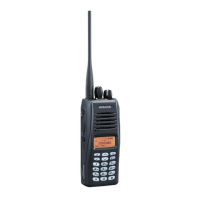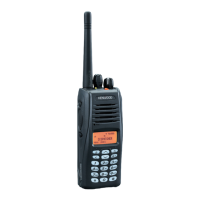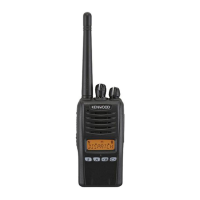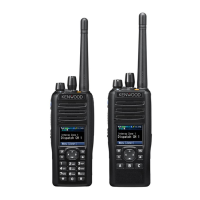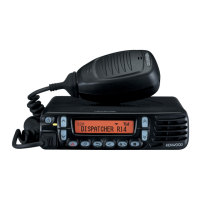Do you have a question about the Kenwood Nexedge and is the answer not in the manual?
Details the pin assignments and functions of the universal connector.
Specifies the impedance of the transceiver's antenna terminal.
Describes the battery terminal connection and mounting method.
Provides critical safety guidelines and warnings for transceiver operation.
Lists all items included in the transceiver package.
Step-by-step guide for attaching and detaching the battery pack.
Instructions for securely attaching the antenna to the transceiver.
How to use the knob to select zones/channels.
Details on turning the transceiver on/off and adjusting volume.
Explains the LED colors for transmission and reception status.
How to activate the programmable auxiliary function.
Description of the Side 1 key's programmable functions.
How to use the Push-To-Talk switch for communication.
Description of the Side 2 key's programmable functions.
Using the keypad for DTMF and zone selection.
Connecting external audio accessories to the universal connector.
Procedures for switching power and managing transceiver password.
How to control the audio volume level.
Steps to select desired zones and channel/group IDs.
Guidelines for making voice transmissions.
How to receive group and individual calls.
How to enter and navigate through the transceiver's menu system.
Details on configuring transceiver settings via the menu.
Describes ways to input characters using keys or keypad.
How to temporarily remove channels from the scan list.
Explains how to use priority channels during scanning.
How the transceiver reverts after a scan pause.
Adding and removing channels/groups from scan lists.
How to select or reprogram priority channels.
Procedures for making and receiving selective calls.
Sending and receiving status messages with the transceiver.
How to view stored received messages.
Handling short and long message transmissions.
Transmitting location data via GPS.
Detailed steps for making DTMF calls manually or via autodial.
Instructions for making telephone calls via trunking.
Step-by-step guide for initiating emergency calls.
How to enable the scrambler for encrypted communication.
In-depth explanation of QT, DQT, OST, and RAN signaling.
Using DTMF, FleetSync, and NXDN ID signaling.
Setting the sensitivity level for VOX operation.
How to use the VOX feature for hands-free communication.
Guide to setting the transceiver's clock time and date.
How to turn the vibrator alert on or off.
Using TOT to limit transmission duration.
How the battery saver conserves power.
How to lock/unlock keys and which keys remain active.
Understanding battery level icons and warnings.
Interpreting the icons for received signal strength.
Using compander for improved audio clarity.
How BCL prevents transmission on busy channels.
How the transceiver finds control channels.
How PTT ID is sent with transmissions.
Recording conversations and creating voice memos.
Configuring automatic responses to individual calls.
How to play back recorded conversations and memos.
How audio prompts announce settings and changes.
Information on RF energy exposure and compliance.
Guidelines for preventing interference with other devices.
| Digital Protocol | NXDN |
|---|---|
| Battery Life | Varies with model and usage |
| Dimensions | Varies with model |
| Weight | Varies with model |
| IP Rating | IP54 |
| Operating Temperature | -30°C to +60°C |
| Modulation | NXDN |


